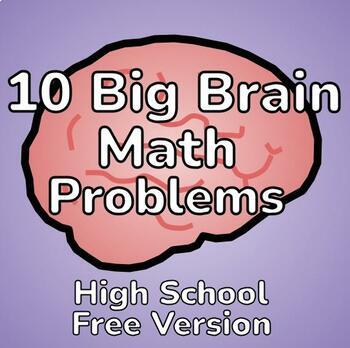10 Free Big Brain Math Problems
Big Brain Math Problems
76 Followers
Grade Levels
9th - 12th
Subjects
Resource Type
Standards
CCSSHSN-RN.A.1
CCSSHSN-RN.A.2
CCSSHSN-RN.B.3
CCSSHSN-Q.A.1
CCSSHSN-Q.A.2
Formats Included
- Google Slides™
Pages
12 pages
Big Brain Math Problems
76 Followers

Made for Google Drive™
This resource can be used by students on Google Drive or Google Classroom. To access this resource, you’ll need to allow TPT to add it to your Google Drive. See our FAQ and Privacy Policy for more information.
Description
This is a sample of the 100 and 180 Big Brain Math Problem I have created with a couple of my students.
I write these problems on the window of my classroom everyday and get about 5-10 students a day coming to try to solve them. It's been an enjoyable experience to have students come try the problem of the day and share their solutions with me.
Please consider purchasing the 100 or 180 Big Brain Math Problems. There's enough for one a day for the entire school year and range from 1-5 Star difficulty.
Total Pages
12 pages
Answer Key
Included
Teaching Duration
Lifelong tool
Last updated Feb 26th, 2022
Report this resource to TPT
Reported resources will be reviewed by our team. Report this resource to let us know if this resource violates TPT’s content guidelines.
Standards
to see state-specific standards (only available in the US).
CCSSHSN-RN.A.1
Explain how the definition of the meaning of rational exponents follows from extending the properties of integer exponents to those values, allowing for a notation for radicals in terms of rational exponents. For example, we define 5 to the 1/3 power to be the cube root of 5 because we want (5 to the 1/3 power)³ = 5 to the (1/3)(3) power to hold, so (5 to the 1/3 power)³ must equal 5.
CCSSHSN-RN.A.2
Rewrite expressions involving radicals and rational exponents using the properties of exponents.
CCSSHSN-RN.B.3
Explain why the sum or product of two rational numbers is rational; that the sum of a rational number and an irrational number is irrational; and that the product of a nonzero rational number and an irrational number is irrational.
CCSSHSN-Q.A.1
Use units as a way to understand problems and to guide the solution of multi-step problems; choose and interpret units consistently in formulas; choose and interpret the scale and the origin in graphs and data displays.
CCSSHSN-Q.A.2
Define appropriate quantities for the purpose of descriptive modeling.





